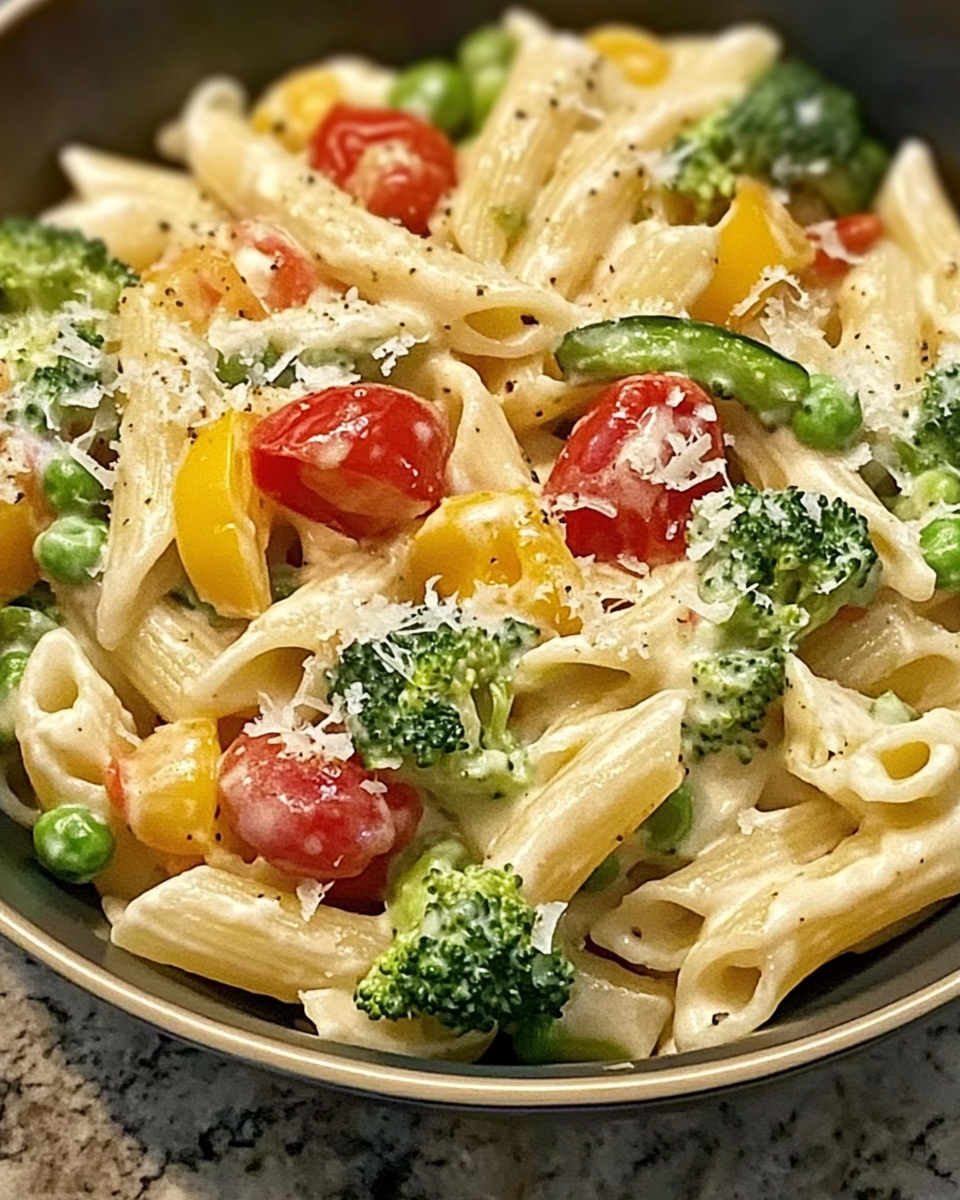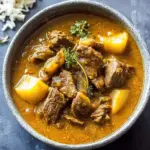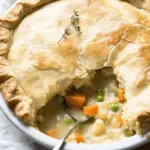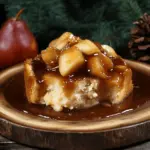The brilliance of Pasta Primavera lies in its simplicity and freshness. Loaded with seasonal vegetables like zucchini, squash, cherry tomatoes, and broccoli, this dish is a celebration of the harvest. Tossed gently with pasta, olive oil, garlic, and a touch of lemon juice, it’s the perfect balance of flavor, nutrition, and ease.
Ideal for busy weeknights or light weekend dinners, this recipe lets the veggies shine while keeping the prep minimal. It’s endlessly versatile, sub in your favorite garden produce or use up leftovers from the fridge. Whether you’re vegetarian, aiming to eat more plant-based, or just craving something clean and colorful, this Pasta Primavera will hit the spot every time.
Full Recipe:
Ingredients:
-
12 oz pasta (penne or fettuccine)
-
2 tablespoons olive oil
-
1 red bell pepper, thinly sliced
-
1 yellow squash, thinly sliced
-
1 zucchini, thinly sliced
-
1 cup cherry tomatoes, halved
-
1 cup broccoli florets
-
3 garlic cloves, minced
-
1/2 cup frozen peas
-
1/4 teaspoon crushed red pepper flakes (optional)
-
1/4 cup grated Parmesan cheese (optional or vegan alternative)
-
Juice of 1 lemon
-
Salt and pepper to taste
-
1/4 cup fresh basil, chopped
Directions:
-
Cook pasta according to package directions until al dente. Reserve 1 cup of pasta water, then drain and set aside.
-
In a large skillet, heat olive oil over medium heat.
-
Add the garlic and cook for 1 minute until fragrant.
-
Add red bell pepper, zucchini, yellow squash, and broccoli. Cook for 5–7 minutes, stirring occasionally, until vegetables are tender but crisp.
-
Stir in cherry tomatoes, peas, and crushed red pepper flakes (if using). Cook for 2–3 minutes more.
-
Add the cooked pasta to the skillet along with the reserved pasta water a little at a time, stirring until everything is well combined.
-
Squeeze fresh lemon juice over the pasta and season with salt and pepper.
-
Sprinkle with Parmesan cheese and fresh basil before serving.
Prep Time: 15 minutes | Cooking Time: 20 minutes | Total Time: 35 minutes
Kcal: 375 kcal | Servings: 4 servings
Why Pasta Primavera is the Perfect Dish for Seasonal Cooking
When it comes to cooking that is fresh, colorful, satisfying, and easy on the environment, Pasta Primavera reigns supreme. Originating in North America in the 1970s, this dish was designed to showcase spring and summer vegetables at their peak, and its appeal hasn’t waned since. Whether you’re following a vegetarian diet, trying to eat more sustainably, or simply craving a delicious, veggie-packed pasta, Pasta Primavera hits every mark.
With its vibrant medley of vegetables, light olive oil base, and bright touches of lemon and herbs, this dish captures the spirit of fresh, seasonal eating. And what’s more, it’s endlessly customizable, making it ideal for zero-waste kitchens and creative cooks alike.
Let’s dive deeper into what makes Pasta Primavera a staple worth revisiting and reinventing.
A Brief History of Pasta Primavera
Despite its Italian-sounding name, Pasta Primavera is actually an American creation. The term “primavera” means “spring” in Italian, and while the concept of tossing vegetables with pasta has roots in Mediterranean cuisine, the specific combination popularized by this dish is credited to Sirio Maccioni, an Italian restaurateur. According to popular lore, Maccioni developed the dish during a trip to Canada in the 1970s, and it quickly became a favorite at New York’s famed Le Cirque restaurant.
At a time when heavy cream sauces and meat-laden entrees dominated menus, Pasta Primavera offered something radically different: a fresh, plant-forward dish that relied on the natural beauty and flavor of vegetables rather than ornate preparations. The original version even included a bit of cream and cheese, but modern takes often lean lighter and brighter exactly like the one on our site.
The Beauty of Seasonality
One of the biggest appeals of Pasta Primavera is that it’s designed to be seasonal. That means you can make it again and again throughout the year and never grow bored of it. While the classic spring combination might include zucchini, bell peppers, cherry tomatoes, and peas, you can switch things up based on what’s freshest in your area.
In spring, opt for asparagus, peas, baby spinach, and leeks.
In summer, try eggplant, yellow squash, cherry tomatoes, and sweet corn.
In fall, butternut squash, kale, and roasted red peppers bring a warm, hearty twist.
Even in winter, you can work with sautéed mushrooms, Brussels sprouts, and winter greens like chard or collards.
This adaptability is a cornerstone of zero-waste and sustainable cooking. Using what you already have or what’s most abundant and local, ensures you’re not only reducing food waste but also supporting regional agriculture and reducing your carbon footprint.
Zero-Waste and Kitchen Efficiency
If you’re looking to align your cooking with low-waste living, Pasta Primavera is an ideal starting point. Here’s why:
-
Flexible Veggies: Nearly any vegetable can work, which means you can rescue that half bell pepper, those last few broccoli florets, or the slightly soft zucchini from going to waste.
-
Minimal Packaging: Fresh produce usually comes with far less packaging than frozen or canned options, especially if you shop at farmers markets or use reusable produce bags.
-
One-Pan Simplicity: This recipe uses minimal pots and pans, saving water during cleanup.
-
Compost-Friendly Scraps: Garlic peels, onion skins, and herb stems can be composted or saved for making veggie stock later.
Plus, pasta itself is one of the most economical and low-waste pantry staples. It stores well, has a long shelf life, and pairs beautifully with everything from beans to cheese to veggies.
Nutritional Highlights
Don’t let its simple ingredients fool you, Pasta Primavera is a nutritional powerhouse.
-
Fiber & Antioxidants: Thanks to the wide variety of vegetables, this dish delivers fiber for digestion and antioxidants to fight inflammation and boost immunity.
-
Healthy Fats: Olive oil adds heart-healthy monounsaturated fats, which help absorb the fat-soluble vitamins in your veggies.
-
Vitamins Galore: Bell peppers offer vitamin C, cherry tomatoes provide lycopene, peas are rich in vitamin K and protein, and zucchini brings potassium and folate.
-
Low-Calorie Satisfaction: Unlike creamy or meat-heavy pastas, this one fills you up without weighing you down, making it ideal for those looking to maintain a healthy weight or avoid overly processed meals.
And if you’re vegan or dairy-free, just skip the cheese or use a plant-based alternative. The recipe is easily adaptable without losing its nutritional or culinary value.
Make It Your Own: Variations and Additions
While the base recipe is fabulous as-is, here are some simple ways to mix it up:
-
Add Protein: Toss in grilled tofu, chickpeas, white beans, or a soft-boiled egg for added protein without sacrificing the plant-forward nature of the dish.
-
Use Whole-Grain Pasta: This boosts fiber and gives the dish a nuttier taste.
-
Try a Different Sauce Base: While olive oil and lemon keep it light, you could try a homemade pesto, a dollop of vegan ricotta, or even a spoonful of tomato purée.
-
Spice It Up: A pinch of chili flakes, a dash of smoked paprika, or fresh cracked black pepper can add depth and heat.
-
Make It Gluten-Free: Swap regular pasta for gluten-free options like brown rice pasta, chickpea pasta, or lentil pasta.
Meal Prep and Leftover Tips
Another fantastic thing about Pasta Primavera? It stores and reheats like a dream.
-
Refrigerator Storage: Store leftovers in an airtight container for up to 4 days.
-
Cold Pasta Salad: Leftovers can be eaten cold as a refreshing pasta salad, just add a splash of lemon juice or a drizzle of olive oil to freshen it up.
-
Reheat Tip: Add a tablespoon of water or broth to your pan before reheating on the stove to keep the pasta from drying out.
This dish is ideal for meal prep Sundays, busy weekday dinners, or packed lunches for work or school.
Pairing Ideas for a Complete Meal
If you want to turn your Pasta Primavera into a complete dinner experience, consider these additions:
-
Appetizers: A simple garden salad with balsamic vinaigrette or a small bowl of soup like minestrone.
-
Sides: Garlic bread or roasted carrots with thyme.
-
Drinks: Pair it with a crisp white wine like Sauvignon Blanc, a sparkling mocktail, or lemon-infused water.
-
Desserts: End the meal with something light, like lemon sorbet, a fruit salad, or a slice of almond cake.
Eco-Friendly and Budget Friendly
With the rising costs of groceries and increased awareness of climate change, more families are turning to recipes that are budget-conscious and earth-conscious. Pasta Primavera fits the bill perfectly. It’s inexpensive, uses ingredients that are often already in your fridge or pantry, and doesn’t rely on specialty items.
Even better, cooking it yourself means you control every ingredient, no hidden preservatives, excess salt, or surprise allergens. It’s real food made simple.
Conclusion
Pasta Primavera is more than just a meal; it’s a philosophy of cooking. It’s about embracing simplicity, celebrating nature’s bounty, and making delicious, healthy meals accessible to everyone. With its fresh vegetables, bright flavors, and low-waste potential, it’s the perfect recipe to have in your back pocket for any night of the week.
Whether you’re feeding your family, hosting friends, or cooking solo, this dish delivers on flavor, nutrition, and sustainability. Once you try it, you’ll see why it’s been a classic for over 50 years and why it continues to evolve with every new season of produce.
So, the next time you’re standing in front of your fridge wondering what to cook, let Pasta Primavera be your go-to. It’s proof that the best meals often come from what’s already on hand and from cooking with love and intention.






